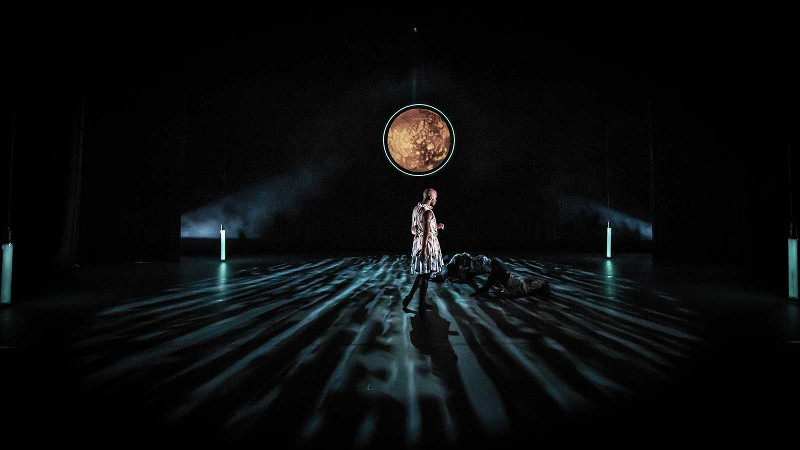
To take a summer break by visiting New York City (as I am), at a time when dance is mostly happening at bucolic out-of-town festivals, and to run into the prodigious choreographer Kyle Abraham‘s newest work for his Cadillac of a dance company, Abraham in Motion (A.I.M.) — is to luck out.
The 70-minute, intermission-less work Requiem: Fire in the Air of the Earth, a commission by Lincoln Center’s Summer for the City performance series, has at its core Abraham’s ever-evolving movement invention, a pithy feast for choreography junkies, a banquet beyond any single viewing’s capacity to imbibe.
But it was also a feast for all the senses, insofar as the movement-driven dance maker shows increasing sophistication in employing other theatrical elements to enhance his work. In the case of “Requiem,” it’s Dan Scully’s gorgeous set and lighting design that wraps the dancers in hues of yellow, green, red. And it’s the edgy live music-mix by electronic-gal Jlin that sets the room thumping. In other words, Abraham, who first emerged as a dance-world wunderkind circa 2010 is making good on the many grants and awards that gave early recognition to his precocious skills — even crowning him with a MacArthur Foundation “genius” award.
Guess what? I think “Requiem” is a work of genius. Its vulnerabilities exist — primarily in a kind of chutzpah in using Mozart’s magisterial, elegiac music, then, scrambling it into aural wallpaper. Just because you can, perhaps you shouldn’t.
But the dancing. Unleashing his seamless movement chains, Abraham transports his street-dance and modern-dance roots to a higher plane. Then, the unexpected interpolation of ballet enchainment, this from a guy who lately stages works on The Royal and New York City Ballet. His splendid ten-member troupe, with seeming ease, transitions between funky, jittery, dance-waves, as they lift arms high, clasp hands like an overhead lasso, and undulate their torsos. Then they plop to the ground and pirouette on their knees. Even with the use of ballet, it’s all so pleasingly slithery and non-positional. I loved the humor in the witty little gesture-conversations that found their way in, kind of like “losing it,” toward the ending. Hilarious.
But “broken,” not hilarious, is a key word for “Requiem.” The dance finds dancers in various stages of collapse, and they are dressed in a way that at times evokes ragamuffins, at others, noble warriors of the Middle Ages. It looks and feels post-Pandemic (and …why wouldn’t it) insofar as: Who are these people? What are they doing? Why are they doing it? Several men wear skirts, others wear baggy sacks, another dons what looks like a paper-mache tutu.
The evening’s centerpiece is a lengthy, nonstop montage powered by Jlin’s harrowingly throbbing electronic sound that morphs into African beat; the dance goes commensurately tribal. To a clanging, percussive sound, somewhat screechy, Abraham stages moves that crackle like Rice Krispies in milk and percolate like your mother’s plug-in electric coffee maker. The synthesis of dance with sound and light in this section I found it utterly thrilling to watch.
There are chapters. One changeover is as abrupt as switching from one Netflix movie to another. At a certain point, the work switches to silence, and thereafter it goes somewhat downhill. Endings are hard, especially when you have pumped up the volume that loud. (Jack Cole was notorious for not finishing his works and letting his dancers get themselves off stage.) Abraham overly relies on certain cliches, like the collapsed figure gaining support from the rest of the posse. But one early such image, that of a slender female dancer, in collapse, with caring colleagues coming to her rescue, evoked for me Anne Heche’s horrifying end, and the outpouring of concern for whatever agony drove her to it. I don’t remotely suggest Abraham operates that literally. But the association was there for me.
Speaking of happy endings, the night I attended “Requiem” was Kyle Abraham’s birthday. The stylish choreographer, in a blue caftan, got a round of Stevie Wonder’s bubbly version of Happy Birthday — and he danced on stage to it, taking broad, wide steps, feeling the joy.

What a brilliant review! It’s one for the books. You put into words my unexpressed and unable to define feelings about the piece. Brava!